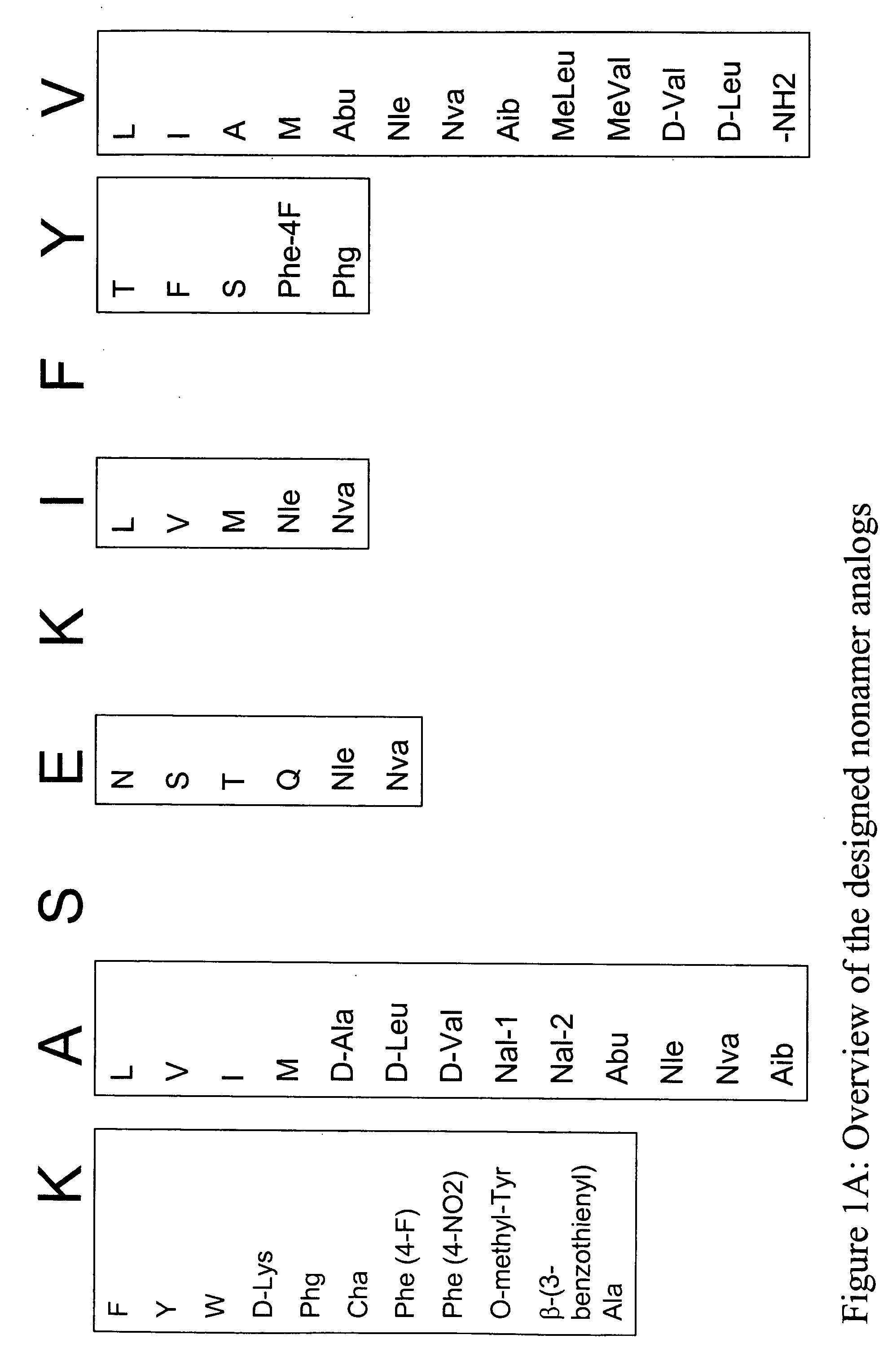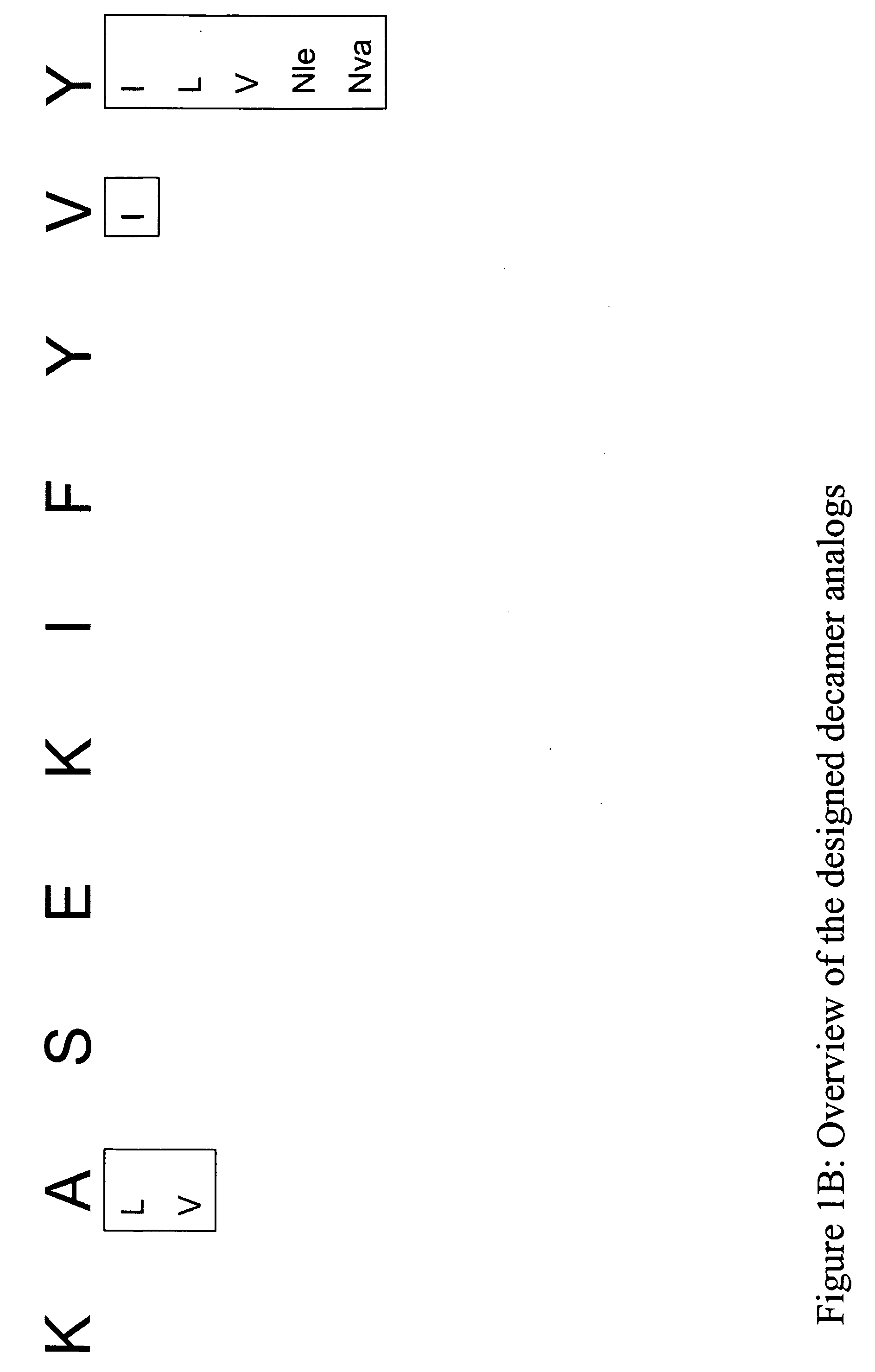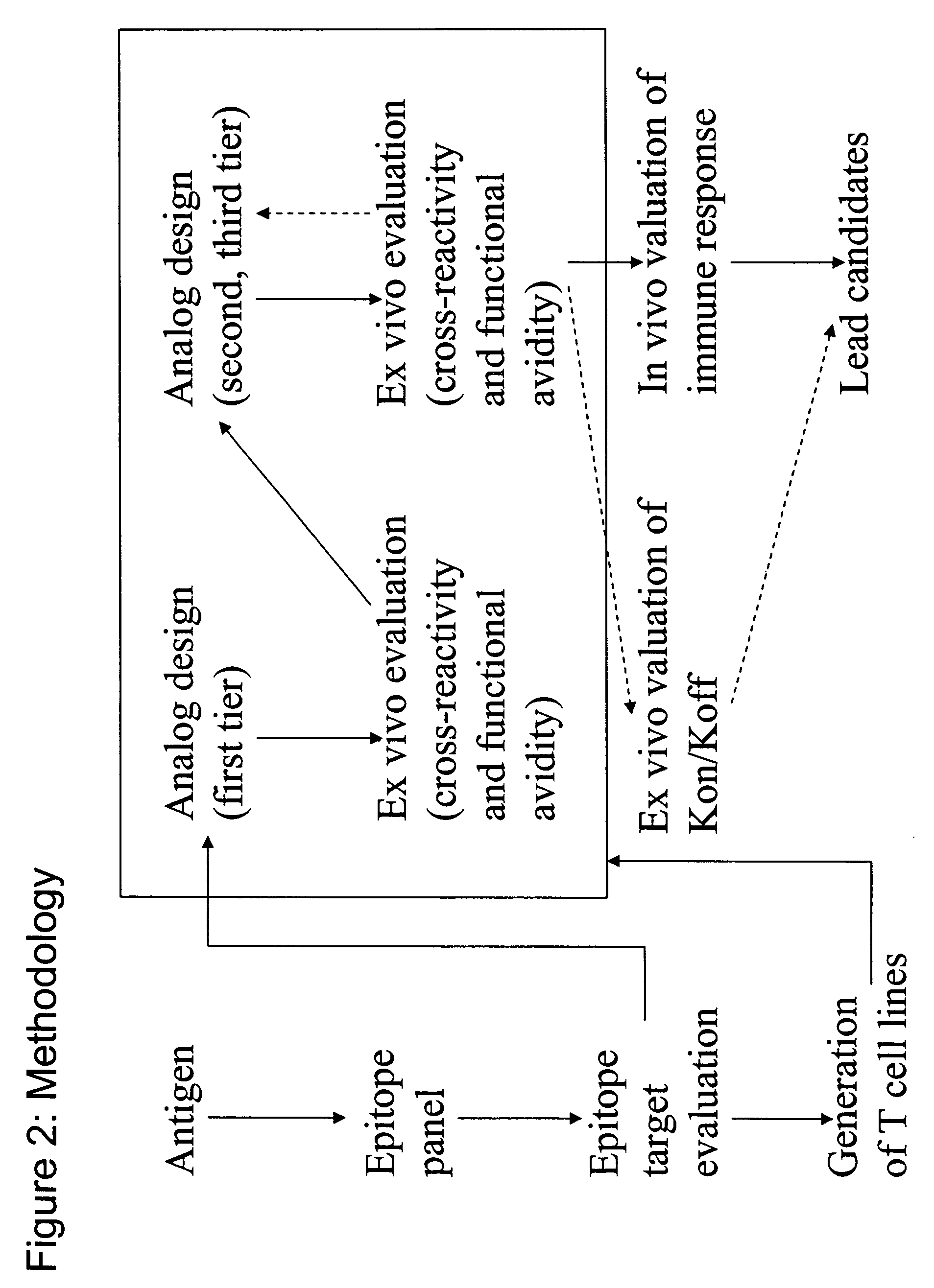Melanoma antigen peptide analogues
a technology of melanoma and antigens, applied in the field of analogues of peptides, can solve the problem that cells do not respond to antigens in a free or soluble form, and achieve the effect of similar or improving immunological properties
- Summary
- Abstract
- Description
- Claims
- Application Information
AI Technical Summary
Benefits of technology
Problems solved by technology
Method used
Image
Examples
example 1
Peptide Synthesis, Purification and Characterization
[0398] Peptides were synthesized on either a Symphony multiple peptide synthesizer (PTI technologies, MA) or an ABI 433A peptide synthesizer (Applied Biosystems, Foster City, Calif.) at 0.05-0.1 mmole scale using standard Fmoc solid phase chemistry. C-terminal free acid peptides were synthesized using pre-load PEG-PS resins (on Symphony) or Wang resin (on ABI). C-terminal amidated peptides were synthesized on Fmoc-PAL-PEG-PS resin. All resins were purchased from Applied Biosystems (Foster City, Calif.). The Fmoc-amino acids used in peptide syntheses were purchased from Novabiochem (San Diego, Calif.) and AnaSpec (San Jose, Calif.). Post-synthesis cleavage was carried on by the standard protocol.
[0399] Peptide purification was carried out on either semi-preparative HPLC columns or SPE cartridges (Phenomenex, Torrance, Calif.). The purity of all peptides was ≧90%. The identity of each peptide was verified by Maldi-TOF MS (Voyager D...
example 2
De novo Designed SSX-241-49 Analogs
[0400] Structural modification of a moderately antigenic peptide can considerably improve peptide-MHC binding, CTL recognition, and / or immunogenicity. General guidelines regarding how to modify a wild-type epitope in order to achieve a peptide analog with enhanced potency are known in the art. An appreciated strategy is to optimize the residues at the so-called anchor positions for binding to the particular MHC molecule at issue. In the case of HLA-A2, a marked preference for hydrophobic residues at the P2 and PΩ positions has been observed, particularly L and M at P2, and V at PΩ. (PΩ denotes the C-terminal residue of the epitope. For HLA-A2, that is P9 or P10 depending on the length of the peptide.) Replacing the P1 position with aromatic residues, such as F, Y and W can also be advantageous.
TABLE 7Coefficients used by the BIMAS algorithm(Algorithm available by hypertext transfer protocol: / / bimas.cit.nih.gov / molbio / hla_bind / )9-mer Coefficient ...
example 3
[0403] The following analogs were produced using the predictions in Example 1.
TABLE 9SEQ IDCategoryNumberPeptide nameSequencewild-type1SSX-2 41-49KASEKIFYVN-terminal Primary Anchor102SSX-2 41-49 (A42L)KLSEKIFYV103SSX-2 41-49 (A42V)KVSEKIFYV104SSX-2 41-49 (A42I)KISEKIFYV105SSX-2 41-49 (A42M)KMSEKIFYV106SSX-2 41-49 (A42(D-Ala))K(D-Ala)SEKIFYV107SSX-2 41-49 (A42(D-Leu))K(D-Leu)SEKIFYV108SSX-2 41-49 (A42(D-Val))K(D-Val)SEKIFYV109SSX-2 41-49 (A42(Nal-1))KNal-1SEKIFYV110SSX-2 41-49 (A42(Nal-2))KNal-2SEKIFYV111SSX-2 41-49 (A42(Abu))KAbuSEKIFYV112SSX-2 41-49 (A42(Nle))KNleSEKIFYV113SSX-2 41-49 (A42(Nva))KNvaSEKIFYV114SSX-2 41-49 (A42(Aib))KAibSEKIFYVN-terminal Secondary Anchor115SSX-2 41-49 (K41F)FASEKIFYV116SSX-2 41-49 (K41W)WASEKIFYV117SSX-2 41-49 (K41Y)YASEKIFYV118SSX-2 41-49 (K41(D-Lys))(D-Lys)ASEKIFYV119SSX-2 41-49 (K41(Phg))PhgASEKIFYV120SSX-2 41-49 (K41(Cha))ChaASEKIFYV121SSX-2 41-49 (K41(Phe-4F))Phe(4-F)ASEKIFYV122SSX-2 41-49 (K41(Phe-4NO2))Phe(4-NO2)ASEKIFYV123SSX-2 41-49 (K41(O-...
PUM
| Property | Measurement | Unit |
|---|---|---|
| length | aaaaa | aaaaa |
| volume | aaaaa | aaaaa |
| volume | aaaaa | aaaaa |
Abstract
Description
Claims
Application Information
 Login to View More
Login to View More - R&D
- Intellectual Property
- Life Sciences
- Materials
- Tech Scout
- Unparalleled Data Quality
- Higher Quality Content
- 60% Fewer Hallucinations
Browse by: Latest US Patents, China's latest patents, Technical Efficacy Thesaurus, Application Domain, Technology Topic, Popular Technical Reports.
© 2025 PatSnap. All rights reserved.Legal|Privacy policy|Modern Slavery Act Transparency Statement|Sitemap|About US| Contact US: help@patsnap.com



